Disclaimers have a long legal history. They generally have two purposes:
- To warn
- To limit liability
A warning sign is likely the earliest and easiest manifestation of a disclaimer.
“No trespassing” alerts passing individuals that they are near a private land boundary and also excuses the landowner of some liability if people visit uninvited.
Sometimes, the warning and limitation of liability are based on statutory law. For example, the state of Washington in the United States has a law that prevents people injured at equestrian facilities from pursuing legal damages.
Any business that boards, trains or allows the riding of horses has to have a specific sign to enjoy this protection from liability. This sign acts as a disclaimer much like a “No trespassing” sign in that it informs and specifies limits on facility responsibilities:
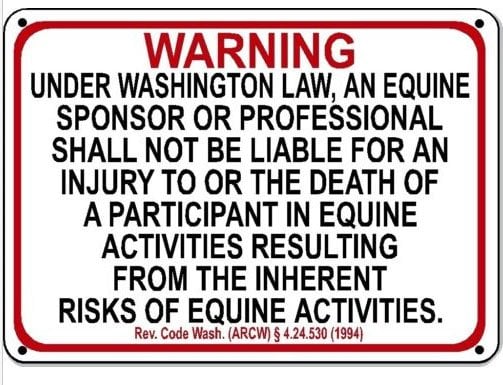
Another area where you would find disclaimers is books.
Publishing consultant, Alicia Dunams, offers samples of disclaimers appropriate for different types of material.
For example, if a book addresses alternative medicine or other treatments not officially approved by regulatory agencies, she recommends this disclaimer or something like it:

Storey Publishing places a general disclaimer in most of its works. A book by Allan Hamilton, M.D. titled Zen Mind, Zen Horse: The Science and Spirituality of Working with Horses, contains this disclaimer because Dr. Hamilton is a neurosurgeon and the book offers horse training advice along with explanations of equine neurology:
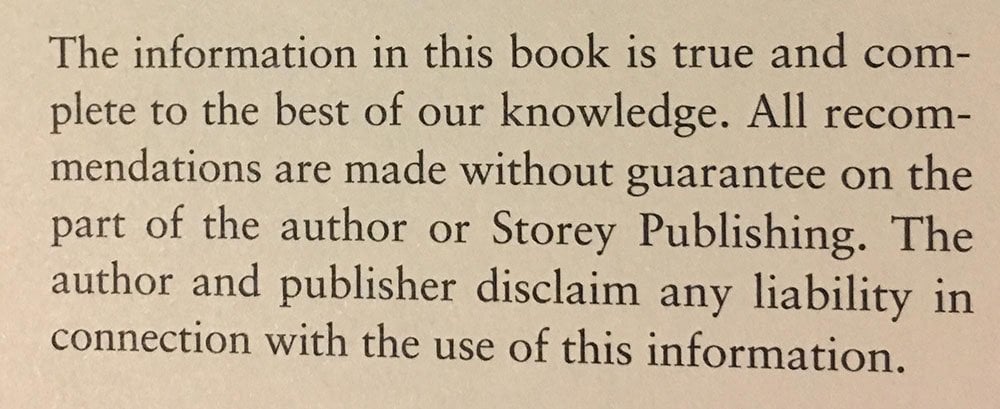
Use the Disclaimer Generator to create a disclaimer.
Placing a disclaimer on websites and apps has the same purpose as those employed before the Internet. While the warning element remains, the primary concern is about limiting responsibility for a user’s’ mistakes.
A common area where disclaimers arise is websites offering alternative health care or medical advice.

iHerb sells vitamin and herbal supplements online. It’s also very careful on how it represents its information and adds this disclaimer:
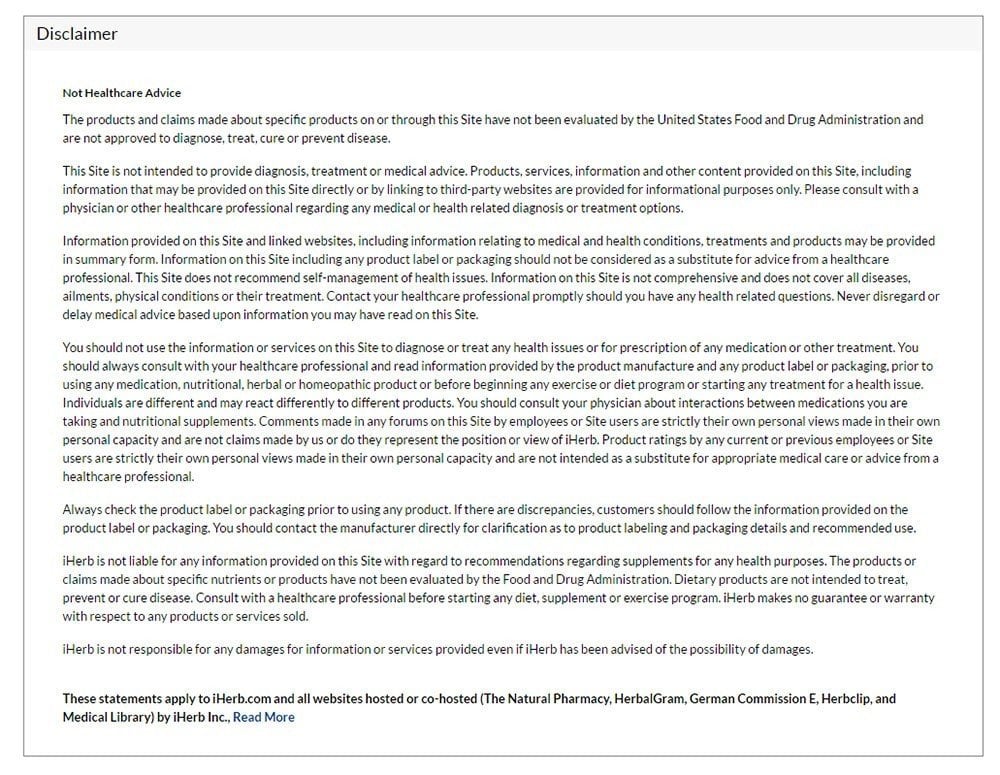
The detail in this medical disclaimer from iHerb is understandable. Supplement companies can make big claims and yet, these have to be discerned thoroughly. iHerb makes it clear that while the products are available for purchase, that does not mean they will always yield the intended benefits.

Wikipedia also proceeds cautiously because the site explains many medical topics. It offers multiple disclaimer pages, including this one regarding medical information:

Medical topics are not the only area where Wikipedia prefers to limit its liability. It also offers a general legal disclaimer page regarding law topics:

There is another one regarding possibly offensive material:

Wikipedia also warns against the risk of following some of the advice on its website, explaining that the information can be misleading, dangerous, addictive or illegal:

There’s also a general disclaimer page where Wikipedia makes it clear that the Wikipedia website accepts content from multiple writers and there’s no guarantee that it is correct:
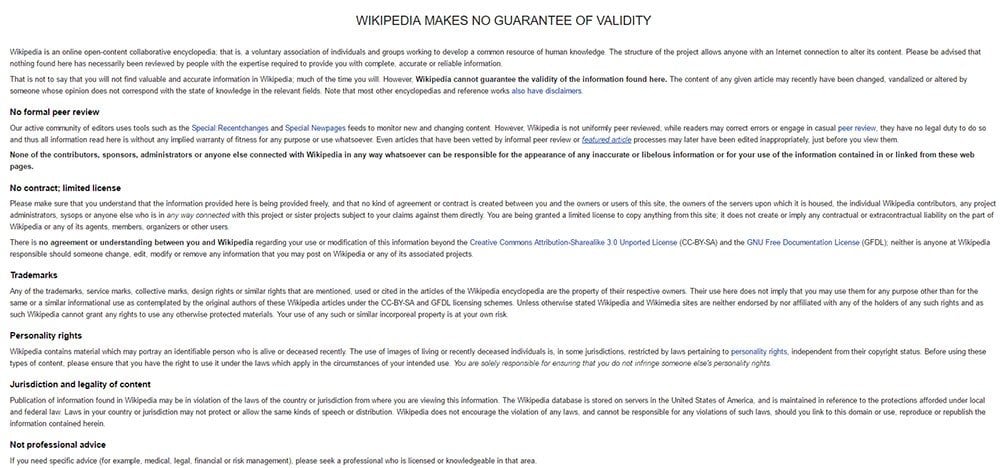
Of course, you may not be as extensive in your needs as Wikipedia. You may want to take the approach of Intertek, a consulting company.

Its legal disclaimer page explains that it provides the best information possible but will not be held liable if the user does not enjoy the intended results.
Intertek’s disclaimer page is titled “Legal Disclaimer” but is really a catch-all of liability:
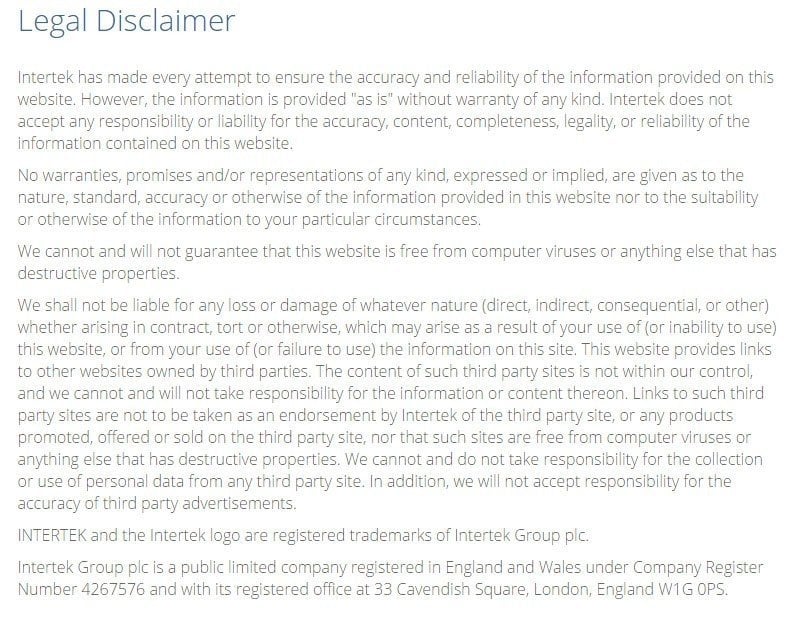
These are examples of disclaimers that are presented as separate documents. Sometimes, disclaimers are included in the Terms and Conditions agreements of a website or mobile app.
Disclaimers in T&C and Privacy Policy
Many businesses developers skip on disclaimers believing the topics are covered in the Terms and Conditions and Privacy Policy agreements of their websites or apps.
In some cases, this is true. Both agreements contain disclaimer language that can act as protection against liability.
The Terms and Conditions act as a set of rules for using the online service and the Privacy Policy explains how you handle personal data.
There can be standards of behavior for users in the Terms and Conditions and limits to the personal data collected in the Privacy Policy. As long as conduct proceeds as addressed in these agreements, you are protected.
However, there are differences which make disclaimers essential.
If there’s a specific risk involved with the use or misuse of your service, a disclaimer addresses that much better.
Sometimes, it’s better to be safe by outlining these risks directly and making the disclaimer easy to locate. Burying content in a Terms and Conditions or Privacy Policy may not serve as enough warning to your users.
Even then, there are businesses developers that dabble in higher risk transactions but do not have a disclaimer. Instead, they opt to include disclaimers in other legal agreements.
One example is the general disclaimer of warranties, as it presents in the Amazon Conditions of Use page. Notice the all-caps easy-to read font and clear language rejecting warranties and limiting liability:
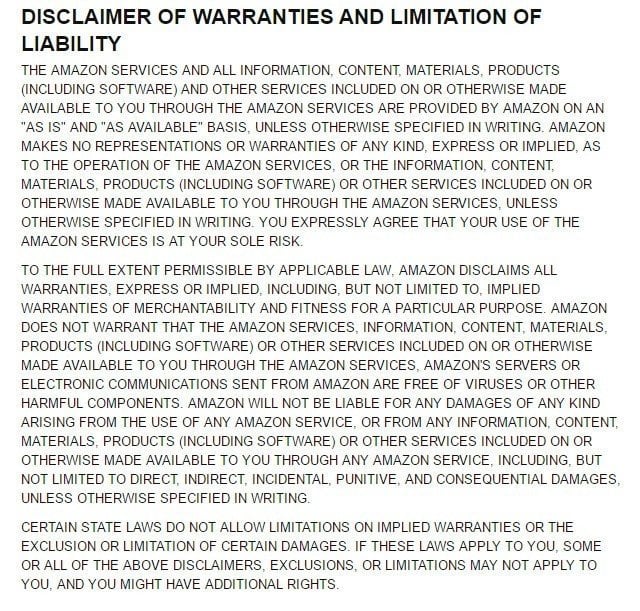

Likely due to the fact that it only trades in information, WebMD also keeps its disclaimer in its Terms and Conditions page. However, it’s very conspicuous and located in the introductory content of that document:
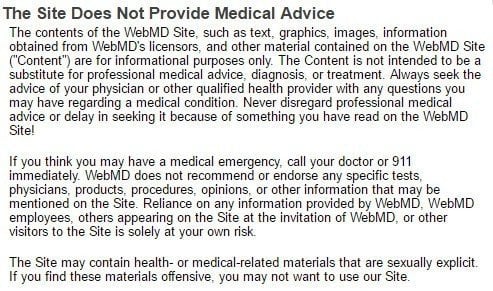
How to enforce disclaimers
Use the Disclaimer Generator to create a disclaimer.
Generally, if a disclaimer is reasonable and easy for a user to find, you can use them as evidence for a court matter.
There may be other factors, like shortcomings in your Terms and Conditions or abusive terms, that can prevent the enforcement of your disclaimers, so disclaimers are not a guarantee of eliminating liability.
Disclaimers work the same way as your other legal agreements.
They give users a heads-up on what to expect and make the limitations of your content, product or services known.
If your disclaimer is easy to find or part of an accessible FAQ (like with Wikipedia), it is likely for a court to agree that the liability is on your user rather than your company.
Developers, bloggers, and writers use them because they do more to hurt than help. If there’s a high risk of misuse, err on the side of providing disclaimers. However, less risky industries can likely proceed fine without them.
When to use a disclaimer
There are particular situations that require disclaimers more than others.
If your service or product falls under any of the following categories, consider posting a disclaimer in a conspicuous place on your website or through your mobile app.
Medical disclaimer
The examples of WebMD, iHerb and Wikipedia showed above emphasize that this is an important area for having disclaimers.
For example, people will often Google their symptoms before making a doctor’s appointment, making disclaimers regarding the effectiveness of online medical information or supplements is sadly necessary.
The last thing your company needs is to face a lawsuit due to misuse of your product or information.
Medical disclaimers are often very detailed, like with iHerb or WebMD.
However, if you merely provide a platform for doctors and other medical professionals to share information with the public, a disclaimer similar to the Wikipedia’s medical disclaimer should be enough.
Blog disclaimer
People rely on professional advice and often do not make the distinction between hiring a professional and reading an expert’s blog.
Attorneys especially face this ordeal.
Potential clients may interpret an attorney’s blog as legal advice and pursue remedies if that fails to work for them.

Lexblog is a service offered by Lexis that gives law firms a platform for their blogs. Each of the blogs on that service includes this disclaimer:

Legal advice disclaimer
The Book Designer offered advice on copyright disclaimer notices in books and wished to make it clear that while the content covered legal elements, this was not professional legal advice:
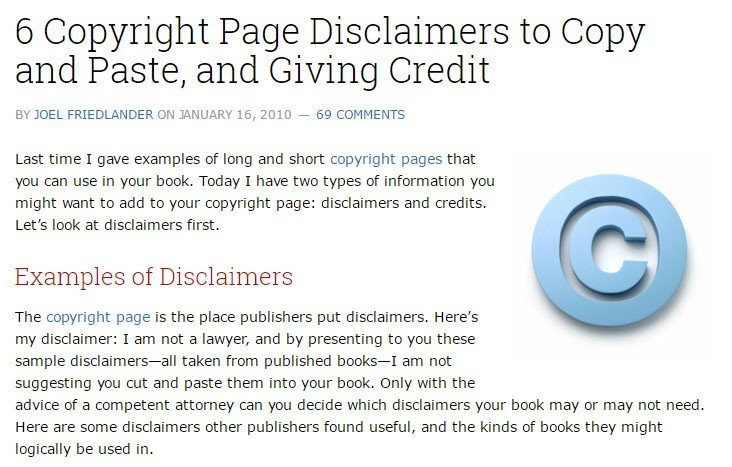
Some bloggers in the publishing arena prefer a more conspicuous approach. Amy Lynn Andrews, who teaches blogging, changes the font and clearly marks the content“Disclaimer”:

If you provide a professional service consider a disclaimer if:
- a) Your reader may confused about duties you owe them and leave you vulnerable to liability (as with attorneys, legal advice and blogs)
- or b) You are advising in an area that is not necessarily within your expertise.This allows the reader to have a clear understanding of your relationship to them and puts them on notice that your tips or advice should be verified by another professional before readers act on them. Otherwise, they assume the risk.
Affiliate disclaimer
Affiliate relationships enter the sticky territory, especially if you are paid for reviewing products.

In 2009, the Federal Trade Commission (FTC) in the U.S. passed rules requiring the disclosure payments received for endorsing products. That requires disclaimers if you have a commercial relationship with another entity where you advance their product or service.
Sewing.org offers a blog with craft tips and reviews products. It offers this disclaimer page regarding reviewed products which specifically mentions the FTC:
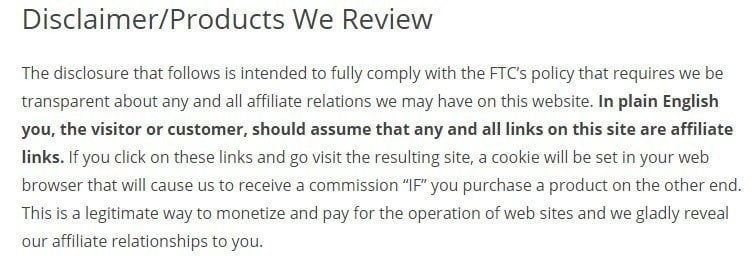
iThemes offers WordPress development tools and also an Affiliate Resource Center for those willing to support it. It contains two examples of disclaimers affiliates should use on their websites:
Example of the first disclaimer:

And the second example:

These types of disclaimers are less about avoiding liability and more about informing users.
It’s fair to inform your readers about any commissions or payments you receive by reviewing or endorsing products.
Disclaimers offer good legal protection when you identify specific legal risks.
Medical, professional, and affiliate circumstances definitely require a disclaimer. If your product, service or content falls under a different category, a disclaimer will merely act as reassurance.
Identify your risks and then decide if you require this extra content in your legal agreements or on your website and/or through your mobile app.
Download Disclaimer Template
Use the Disclaimer Generator to create a disclaimer.
You can also download this Disclaimer Template as a Google Document.
No comments:
Post a Comment